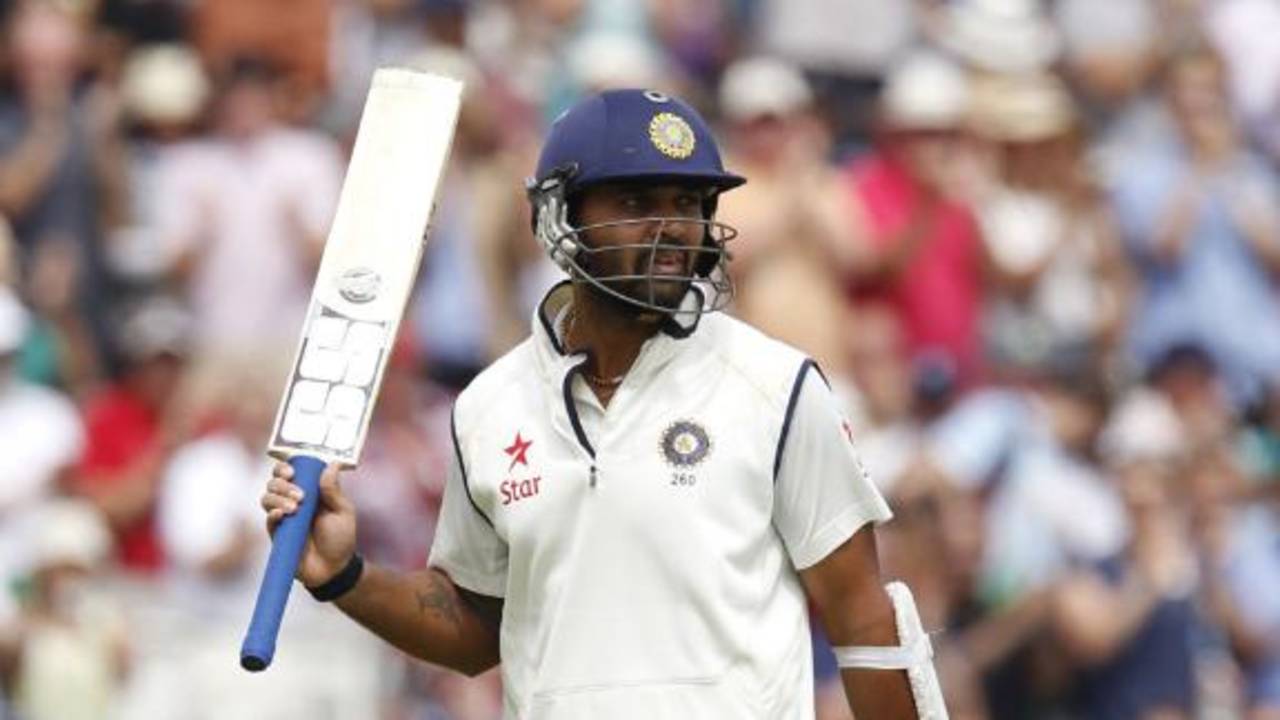M Vijay is the highest run-getter in this series so far. Surprise. He has scored more than Virat Kohli, Cheteshwar Pujara, Ian Bell and Alastair Cook put together. Surprise. His strike-rate is under 40, and he has not offered a shot to 315 balls out of the 922 he has faced. No surprise. However, commentators and observers have been surprised, hailing this effort of 317 runs in four innings so far as Vijay's going against his natural game. Those who have followed Vijay's progress know
this is his natural game in first-class cricket. Although for entirely different reasons, Vijay is, after all, nicknamed Monk.
Since he came back to Test cricket, in the series against Australia in early 2013, Vijay has left alone more balls than any other batsman, even though six of his 12 Tests over the period have been played in India where you don't really need to leave that much. Offering no shot to 620 out of 2281 balls he has faced in these 12 matches, his leaving rate of 27% is higher than anyone else's in Test cricket, among batsmen who have faced at least 1000 balls; Alastair Cook is just behind with 25%. The runs haven't always followed - he didn't get a century in either South Africa or New Zealand - but he has been getting out to either corkers or strangles down the leg side. Now that the runs have accompanied the effort, the world has finally taken notice.
When Vijay finally got out for 95 in the second innings
at Lord's, desperately short of what would have been a memorable hundred on a green pitch tailor-made for the home side, he had for the first time in six away Tests done so playing a nothing push at a ball he would have been better off leaving. This shot wasn't a drive or a punch. Had he middled it he would have sent this back to the bowler or cover. A no-win shot, everyone knows, but darned difficult to avoid, especially for openers. This was a shot most likely brought out by the nerves just before such a big hundred; when the heart is trying to rip its way out of the chest you need to feel bat on ball.
That was also Vijay's first such dismissal in this leg of away Tests; this is exactly the shot he has been successful at avoiding. He has been, as the stats establish, leaving exceptionally well. Leaving is a natural, and a technical, thing. The mind needs to be comfortable not feeling ball on bat for long periods. The back foot needs to go towards the off stump so you judge better which ones you can leave, and so that you at least make the umpire rule you lbw as opposed to leaving your stumps prone should the ball jag back after landing on the seam or hitting a crack. Vijay's back foot goes across. Even Pujara's doesn't go. Kohli was bowled leaving alone at Lord's. Rohit Sharma did that at Kingsmead in the last Test of the last year.
Vijay also has a temperament needed to play that game. He likes to be in a bubble. Just watch the ball, retreat to square leg, then come back and watch the ball again. Even when he hits a four he sees the ball through to the fence instead of running up and down and loosening the limbs a little. He is not much for knocking gloves or long talks between overs either. He can wait for deliveries that are easy to score off. Even after he had finished his hundred
at Trent Bridge, he went 38 deliveries without a run when England bowled well with the second new ball.
Yet Vijay carries a reputation he is supposed to battle against. It is possibly borne out of his IPL exploits; during his most successful days in IPL, over a period of four years, he scored as many IPL centuries as he did in first-class cricket: two. IPL possibly had an impact on his long-form game. When you are playing all three formats and haven't established yourself in any yet, it can mess with your game. Before IPL he was a scorer of big hundreds in first-class cricket; having made his way back, he is the same again.
Vijay says uncertainty didn't help either. Before the comeback that started against Australia, he had played 12 Tests over three years, all thanks to the unavailability of either Gautam Gambhir or Virender Sehwag. He might have even sulked a little. He scored 87 against Sri Lanka when Gambhir was away for his sister's wedding, but didn't get the next game. He got 139 against Australia when Gambhir was injured, but the next match he got was much later, on a greentop similar to Lord's, in Durban.
It is justified to feel unsettled by uncertainty to an extent, but most international careers go through this at the start. Nobody comes in with a right to play a certain number of matches before he can be discarded. To be fair to him, Vijay hasn't made a big deal out of it. And fittingly, he has established himself as a worthy India opener on a track similar to one where he got the opportunity in 2010. And a win similar to that too.
Ajinkya Rahane and Bhuvneshwar Kumar provided the early blows, Ravindra Jadeja gave India the war dance, Ishant Sharma and MS Dhoni sealed the deal, but in between Vijay's calming 95, spread over two crucial days, went under-noticed. He is not in bad company in that regard. Eighteen years ago, at the same venue, two Indians playing their first Test at Lord's charmed the world. One got a hundred, the other 95.

